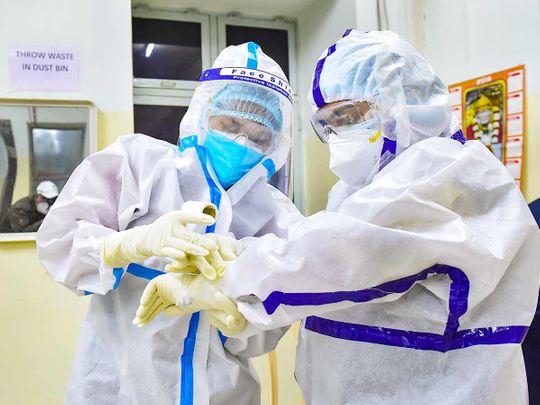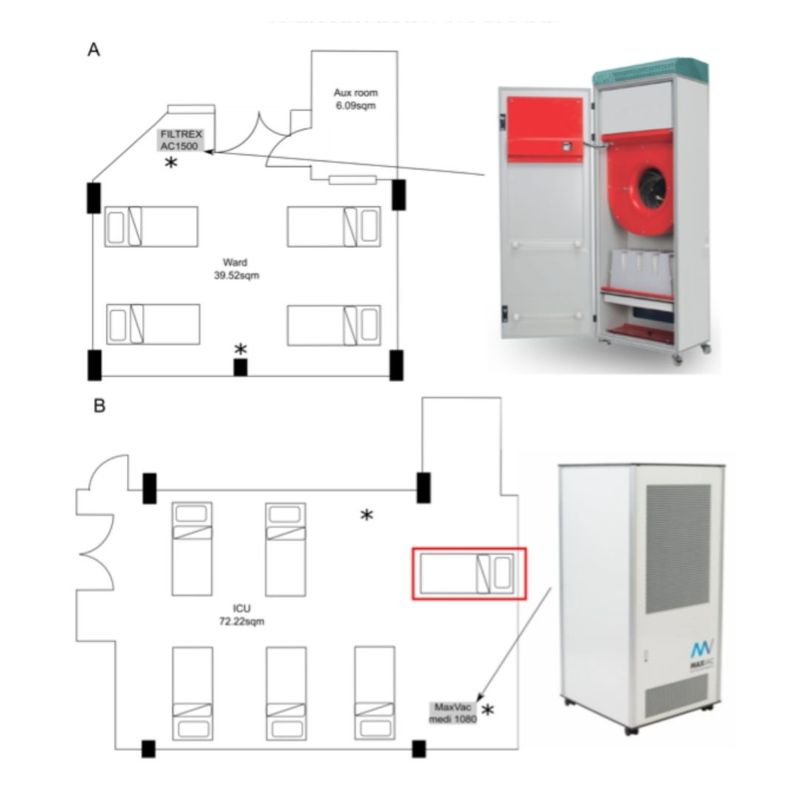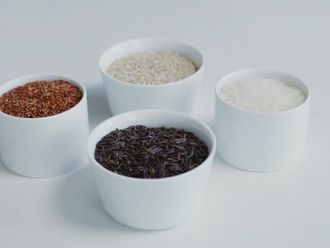
Highlights
- In the first such real-world study, researchers confirmed the effectiveness of HEPA filters in clearing SARS-CoV-2 from hospital wards.
- It confirms COVID is airborne, and spreads mostly as aerosol.
- The air in hospital wards can be cleaned of SARS-CoV-2 using "inexpensive, portable" HEPA filters and UV sterilisation.
Viral particles are reduced substantially in high-risk hospital wards using inexpensive portable air filters and UV sterilisation, a new study shows.
Research conducted by a team led by clinicians at the University of Cambridge in the UK has validated a simple hypothesis: portable air filters, known as high efficiency particulate air (HEPA) filters, effectively remove SARS-CoV-2 particles from the air in hospitals.
Air filtration
In a pre-print study, researchers reported what they described as the first real-world evidence for the use of portable air filters in removing SARS-CoV-2 particles from an indoor hospital setting, according to the journal Nature.

Specifically, the study examined the effect of air filtration and ultra-violet (UV) light sterilisation on detectable airborne SARS-CoV-2 and other microbial “bioaerosols”.
How was the presence of COVID-19 in the air detected?
The researchers conducted a “crossover study of portable air filtration and sterilisation devices” in a COVID and ICU wards in the UK in February.
To detect the presence of airborne SARS-CoV-2 and other microbial bioaerosol with and without air/UV filtration, the team used the National Institute for Occupational Safety and Health (NIOSH) cyclonic aerosol samplers and PCR assays.
What's the problem with bioaerosols?
Hospital-acquired COVID-19 infection, thought to be transmitted through bioaerosols, poses a problem among both patients and staff, primarily due to growing evidence for airborne transmission.
90 %
Amount of the time humans spend indoorsHow were the filters/UV sterilisers tested?
To test drive the filters and how they perform in a hospital setting, tthe devices hey were installed in two fully-occupied COVID-19 wards — a general ward and an ICU room.
The team chose HEPA filters, which catches tiny particles. The researchers then collected air samples from the wards, one week when the air filters were switched on — and two weeks when they were turned off.

What's the implication of the new study?
Here’s the key takeway: SARS-CoV-2 particles were in the air when the filter was off but not when it was on. Now, the researchers suggest measures to remove the virus from the air to include HEPA filters, especially in general wards.
The new research also bolters the use of masks, as scientists believe the virus an infected person exhales stays behind even after the person leaves the room.
It also study suggests that HEPA air cleaners are an affordable and easy way to reduce risk from airborne pathogens.
What’s startling was that the scientists found that HEPA filters don’t only protect against SARS-CoV-2: When they were switched off, the air in both wards also contained detectable amounts of other pathogens that cause infections in hospitals — such as Staphylococcus aureus, Escherichia coli and Streptococcus pyogenes.
The filters largely removed them. These organisms are not typically thought to spread through the air, but this study suggests that these infections may also spread by aerosol, according to another scientist. A study typically goes through a peer-review before it is accepted for print.
The dental study, however, did not measure the presence of bioaerosols in the indoor air via RT-qPCR test. Rather, the researchers only measured filtration efficiency by measuring aerosol concentration before and after air flow through the filter media on first use.
The study found that an air purifier with F6 class filter media removed 54% of aerosols that may carry airborne SARS-CoV-2, while the one with H12 class filter media removed 83% of such aerosols.
The researchers concluded: "Therefore, for dental treatments generating a large amount of aerosols, air purifiers with HEPA may be more effective and protective for DHCWs (dental healthcare workers) than air purifiers with fine filters. Also, air purifiers with F6 class filter media may still have some efficacy."
What happened when air filtration was activated?
Before the activation of the air/UV filtration, researchers detected airborne SARS-CoV-2 virus floating about in the ward on all five days, data showed. On the other hand, when activating the air/UV filters, researchers detected no airborne SARS-CoV-2 virus of the five days.
Again, SARS-CoV-2 was detected on four out of five days when the filter was off. In the ICU, no airborne SARS-CoV-2 particles were found — even when the filter there was off. The authors suggest several possible reasons for this, including slower viral replication at later stages of the disease.
“Filtration significantly reduced the burden of other microbial bioaerosols in both the ward (48 pathogens detected before filtration, two after) and the ICU (45 pathogens detected before filtration, five after),” researchers stated.
The research is yet to be peer reviewed. If accepted for publication, it's important for a several reasons:
- The air in hospital wards or repurposed ICU “surge” wards can be cleaned of SARS-CoV-2 using inexpensive HEPA filters and UV filtration.
- It’s the first real-world study to confirm the utility of HEPA filters and UV sterilisation in clearing SARS-CoV-2 in a hospital ward.
- Not only does it confirm COVID is airborne, but it also shows simple ways to protect healthcare workers in their daily work taking care of COVID patients.
- It also confirms previous research work which showed that ventilation not only helps in terms of infectious disease — i.e. this virus and others — but also it has many benefits. “And one is better cognitive function performance,” he said.
It also confirms previous research work which showed that ventilation not only helps in terms of infectious disease — i.e. this virus and others — but also it has many benefits. “And one is better cognitive function performance,” he said.
“We’re an indoor species. We spend 90% of our time indoors,” said author Prof. Joseph Allen, of the Harvard School of Public Health and co-author of the book “Healthy Buildings”. in a previous interview and was not part of the study. “The indoor environment have this massive, massive impact on our health."
Prof. Allen added, however, that fewer people — even to this day — are thinking about ventilation and filtrations in their homes, offices, schools. “We know how to keep kids and adults safe in school."
Most literature shows that in real-world operation, the HEPA provides 99.97% of the removal of bio-aerosols from ambient air.
What filter/UV sterilisation gear was used?
In the ward, the researchers installed a Filtrex AC1500 HEPA14/UV steriliser; in the ICU, a Max Vac Medi 10 HEPA13/UV steriliser Max Vac was used.
Before the initiation of the three-week study period, the air filters were placed in fixed positions and switched on at the beginning of Week 2 and run continuously from Sunday to Sunday for 24 hours per day. This providing approximately 5-10 room-volume filtrations per hour in each location.
The samplers were operated on weekdays (0815 hours to 1415 hours) for 3 weeks straight. After sampling, the samplers were disassembled using sterile technique and the filter papers were transferred to 15 ml Falcon tubes. The samples were processed then stored at −80°C until analysis. The samplers were washed with 80% ethanol and demineralised water.
“As the devices do not meet medical device electrical safety standards (EN60601) they were operated at a distance of 1.5metres from any patient,” the researchers stated. No price was mentioned for the devices,
What is aerosol transmission?
There's a growing body of evidence that SARS-CoV-2 is primarily transmitted through aerosol particles, or ultra-tiny particles loaded with virus wafting about in the air, especially in indoor settings. While ballistic droplets can be seen by the naked eye and drop almost immediately on the ground, respiratory micro-particles float in the air longer when an infected person sneezes, breathes or talks.
Specifically, the researchers provided evidence for the circulation of SARS-CoV-2 in a hospital ward within “airborne droplets” of >1μM (microns).
“Droplets of 1-4μM are likely a key vehicle for SARS-CoV-2 transmission, as they can remain airborne for a prolonged period. They are also readily respirable and can deposit in the distal airways,” the researchers stated.

“Recent data has shown that exertional respiratory activity, such as that seen in patients with COVID-19, increases the release of 1-4 μM respiratory aerosols, whilst conventionally defined ‘aerosol generating procedures’ such as high flow nasal oxygen and non-invasive ventilation actively reduce aerosol generation during exertion,” they stated.
“These data are consistent with our observations, suggesting that precautions to remove aerosolisation may be more important in conventional wards than in well-defined ‘aerosol risk areas’,” the researchers stated. “We also found a low burden of SARS-CoV-2 in the air on the ICU. This observation, combined with the higher level of aerosol protection worn by ICU staff, may explain why staff in these areas appear to be at significantly lower risk of acquiring COVID than those working on wards,” they said.
How are airborne viruses detected?
Several approaches have been developed by researchers to sample and detect airborne viruses. There’s no agreed standard yet for their use or interpretation.
However, using a high cycle threshold (CT) value, SARS-CoV-2 RNA airborne viruses can be detected using the RT-qPCR method, the scientists said.
The detection of SARS-CoV-2 RNA in the air of a ward managing patients with COVID-19 shows that airborne transmission is a key mechanism by which healthcare professionals could become infected during patient care.
• The detection of SARS-CoV-2 viral RNA in the air of a ward with COVID-19 patients shows airborne transmission us a key mechanism by which healthcare professionals could become infected during patient care.
• The study shows that inexpensive, portable filters are proven to help reduce COVID-19 particles in hospital wards.
• The pre-print study is the first to confirm that hospital-acquired COVID infections can be minimised with the use of portable air filters.








